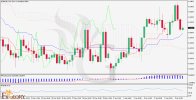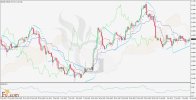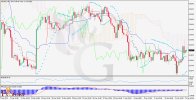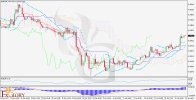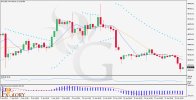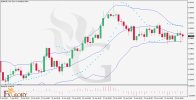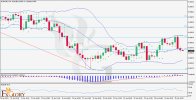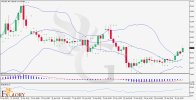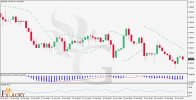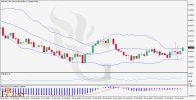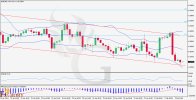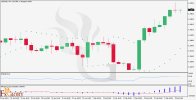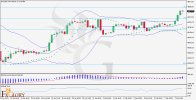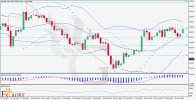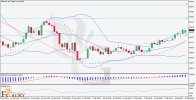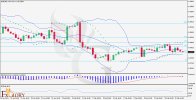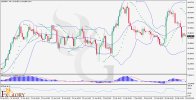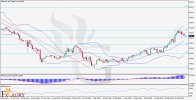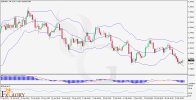FXGlory Ltd
Member
Gold analysis for 08.01.2023
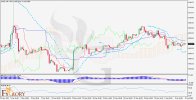
Time Zone: GMT +2
Time Frame: 4 Hours (H4)
Fundamental Analysis:
Gold prices are influenced by a variety of global economic factors, including interest rate trends, geopolitical stability, and inflationary pressures. As gold is often seen as a safe-haven asset, its value tends to increase during times of economic uncertainty or when inflation is high, as investors look for stable stores of value. Central bank policies, particularly those of the Federal Reserve, can significantly impact gold prices as they affect the US Dollar's strength. Current geopolitical tensions or economic policies can also sway investor sentiment and demand for gold.
Price Action:
The H4 chart for gold shows a period of consolidation following a downtrend, with the price action now testing the Ichimoku cloud from below. The recent price movement indicates hesitation as the market is deciding whether to continue the downtrend or reverse into a bullish phase. The candles within the Ichimoku cloud suggest uncertainty, as the cloud typically represents a zone of support or resistance.
Key Technical Indicators:
Ichimoku Kinko Hyo: The price is currently interacting with the Ichimoku cloud, indicating a potential trend change or increased volatility.
RSI (Relative Strength Index): With an RSI reading of around 45, the market is neither overbought nor oversold, reflecting a neutral momentum.
MACD (Moving Average Convergence Divergence): The MACD histogram is below the baseline, indicating bearish momentum, although the bars appear to be shortening, suggesting a possible slowdown in downward momentum.
Parabolic SAR: The dots being below the price candles signal a potential bullish reversal, as the indicator typically suggests a stop and reverse point for the trend.
Support and Resistance:
Resistance: The immediate resistance level can be marked by the latest local high before the price entered the Ichimoku cloud, approximately at $2070.
Support: The most prominent support level would be the recent low prior to the price's uptick into the Ichimoku cloud, which is around $2020.
Conclusion and Consideration:
The gold market on the H4 timeframe is at a critical juncture, with technical indicators showing mixed signals. The interaction with the Ichimoku cloud and the position of the Parabolic SAR suggest a potential bullish reversal, while the MACD indicates ongoing bearish momentum. Traders should be cautious and consider waiting for a clearer signal outside of the Ichimoku cloud before entering positions. It is advisable to monitor global economic indicators and central bank statements, as they can lead to sudden shifts in gold prices. Risk management strategies, including setting stop losses and profit targets, should be employed to protect against market volatility.
Disclaimer: This analysis is provided for informational purposes only and should not be construed as investment advice. It is important for traders to conduct their own research and analysis before making any investment decisions.
FXGlory
08.01.2023

Time Zone: GMT +2
Time Frame: 4 Hours (H4)
Fundamental Analysis:
Gold prices are influenced by a variety of global economic factors, including interest rate trends, geopolitical stability, and inflationary pressures. As gold is often seen as a safe-haven asset, its value tends to increase during times of economic uncertainty or when inflation is high, as investors look for stable stores of value. Central bank policies, particularly those of the Federal Reserve, can significantly impact gold prices as they affect the US Dollar's strength. Current geopolitical tensions or economic policies can also sway investor sentiment and demand for gold.
Price Action:
The H4 chart for gold shows a period of consolidation following a downtrend, with the price action now testing the Ichimoku cloud from below. The recent price movement indicates hesitation as the market is deciding whether to continue the downtrend or reverse into a bullish phase. The candles within the Ichimoku cloud suggest uncertainty, as the cloud typically represents a zone of support or resistance.
Key Technical Indicators:
Ichimoku Kinko Hyo: The price is currently interacting with the Ichimoku cloud, indicating a potential trend change or increased volatility.
RSI (Relative Strength Index): With an RSI reading of around 45, the market is neither overbought nor oversold, reflecting a neutral momentum.
MACD (Moving Average Convergence Divergence): The MACD histogram is below the baseline, indicating bearish momentum, although the bars appear to be shortening, suggesting a possible slowdown in downward momentum.
Parabolic SAR: The dots being below the price candles signal a potential bullish reversal, as the indicator typically suggests a stop and reverse point for the trend.
Support and Resistance:
Resistance: The immediate resistance level can be marked by the latest local high before the price entered the Ichimoku cloud, approximately at $2070.
Support: The most prominent support level would be the recent low prior to the price's uptick into the Ichimoku cloud, which is around $2020.
Conclusion and Consideration:
The gold market on the H4 timeframe is at a critical juncture, with technical indicators showing mixed signals. The interaction with the Ichimoku cloud and the position of the Parabolic SAR suggest a potential bullish reversal, while the MACD indicates ongoing bearish momentum. Traders should be cautious and consider waiting for a clearer signal outside of the Ichimoku cloud before entering positions. It is advisable to monitor global economic indicators and central bank statements, as they can lead to sudden shifts in gold prices. Risk management strategies, including setting stop losses and profit targets, should be employed to protect against market volatility.
Disclaimer: This analysis is provided for informational purposes only and should not be construed as investment advice. It is important for traders to conduct their own research and analysis before making any investment decisions.
FXGlory
08.01.2023



